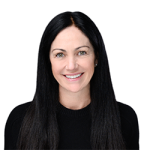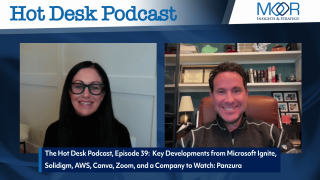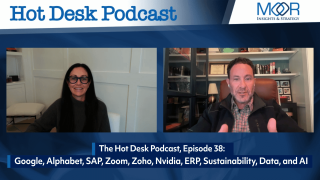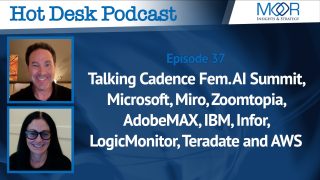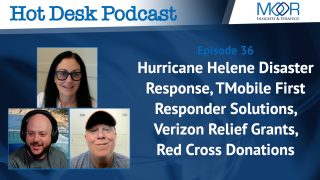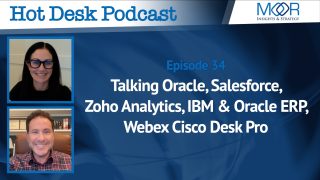On this episode of the Moor Insights & Strategy Hot Desk Podcast, host Melody Brue, VP and Principal Analyst, welcomes John Wall, SVP and CFO and KT Moore, VP of Marketing of Cadence Design Systems, a leading semiconductor design company for a conversation about the company’s recent $50 million purpose-driven investment in an impact investment program managed by Royal Bank of Canada’s Global Asset Management Group.
Key takeaways:
- The investment is one of the largest corporate impact investments to address racial wealth inequities and will focus on affordable housing, homeownership, and small business in specific locations where Cadence has operations and a community presence, as well as internationally on projects to support women, people of color, and climate issues.
- The goal of the investment is to create opportunities for underrepresented people who may not have access to funding or other resources.
- Cadence encourages other companies to join the program and make a similar impact.
- The program is designed to be scalable and easy for other companies to adopt.
- The investment is intended to make a real difference in BIPOC (Black, Indigenous, People of Color) communities in the United States and internationally.
- Cadence believes that addressing the racial wealth gap is one of society’s most important challenges. The company hopes that its investment program will help to create a more equitable future for all.
Cadence is known for its innovation and knack for tackling the biggest problems. KT and John believe that this same spirit of innovation can be applied to solving social problems such as racial inequality. The company’s investment is a significant step in the right direction. This positive development for the company, the tech industry, and society demonstrates corporations’ growing interest and commitment in using their capital to tackle racial wealth inequities.
Watch the video here:
Or Listen to the full audio here:
Disclaimer: This show is for information and entertainment purposes only. While we will discuss publicly traded companies on this show. The contents of this show should not be taken as investment advice.
Transcript:
Melody Brue: Hello, I’m Melody Brue, Vice President and Principal Analyst at Moor Insights and Strategy, and we are here for a special insider edition of the Hot Desk Podcast where we discuss hot takes in the modern workplace. I am joined by John Wall, senior Vice President and CFO and KT Moore, Vice President of Corporate Marketing at Cadence Design Systems. Welcome, John and KT. How are you guys doing?
KT Moore: Great, just another day in Paradise.
John Wall: Yes, very good, thanks. Thanks, Melody, nice to meet you.
Melody Brue: Good. It’s nice to have you guys. So let’s get into it. So Cadence recently announced a $50 million purpose-driven investment in an impact investment program managed by Royal Bank of Canada’s global asset management to address racial wealth inequalities, that’s a whole mouthful. So that includes affordable housing, home ownership, small business. Much of this is focused in specific locations where Cadence is operations and a community presence, but I understand a portion of this will also be focused internationally on projects to support women, people of color and climate issues. So what does racial equity mean to you and to Cadence?
KT Moore: I think that’s a great question. When we looked at this, there were events that were happening globally and domestically in our communities and in our society that woke us up to the point, to the realization that we can do a better job, we can do a better job managing and promoting diversity, equity, and inclusion. And so we’ve adopted that as our core, that’s part of our core culture in Cadence. And we look at it for our employees as how we manage our teams and how we hire people. But it’s also important to remember that there’s a community that we serve, there’s a community that we’re involved in, and this gives us an opportunity to create opportunities for underrepresented people that didn’t have access to whether it was funding or access to certain things that they need. And we felt that affordable housing was a good meaningful way to impact communities domestically and internationally.
Melody Brue: Yeah certainly, and we all know it all starts at home. And you’re definitely investing in the places where Cadence has presence and where you’re doing business, right?
KT Moore: Yeah, that’s correct. We’re a global company, but we have several offices in the US so we are focusing on places like the Bay Area, Austin Texas, Pittsburgh, Pennsylvania, Maryland, Columbia Maryland. We have an office in RTP, North Carolina and Boston and Burlington Mass. Those are domestically where we’re investing with RBC to impact affordable housing.
John Wall: And it’s not just places where Cadence is, by the way, because when we talked to RBC, we told them what we really wanted was to have a program that would be truly international and national, right across North America. We said we wanted something that would be like a cookie cutter kind of cut and paste job that other companies if they want to join us, can just copy and paste and do it for their own organization. The reason we picked 50 million was because at the time, I think we were around a 50 billion market cap company, and our desire is that we’ll continue to increase that as the company grows and hopefully we’ll help RBC recruit other companies to join us. And having a generic program that tries to address the problem as opposed to making it a marketing thing would make it easier for other companies to join us.
Melody Brue: Yeah. So KT, you talked about just some things that were happening in a macro environment about sort of what ignited your desire to invest in racial equity. So there’s some other things that you’ve invested in as well, and you’ve talked about trying to bring other companies and other investments into that fold. What is the big desire that you’re trying to address here on that larger level?
KT Moore: Yeah, it’s to impact our communities in a positive way. We look at where we work, we look at where our customers work, we look at the consumers that buy products that were designed with Cadence, and it’s a global impact. So I think looking at how we can not just be known as a software company, but known as a company that cares about not just profitability, but about community, about growing a culture where more young people get exposed to things that are happening that can impact their lives going forward. There’s many options that a lot of underrepresented people don’t have or they’re not aware of, they’re not exposed to, but they still use the products that are designed by our customers that use our software. So I think it’s a really cool idea to be able to help people come to that realization. And so yeah, we just want to make a better impact.
John Wall: And creativity and innovation is deeply embedded in our culture, aren’t they, KT? I mean, KT and I, I love working with him, it’s always the greatest fun. And we’re great friends with our brother who’s the CEO, Anirudh Devgan. And Anirudh, he always wants us to tackle the toughest problems and the company is a truly innovative company. I mean, it was created by engineers for engineers back in the late 80s. And I mean, how often have we heard Anirudh tell us, “You tackle the biggest problem. Go to the customer, ask them what the biggest problem is, and then we’ll go solve it.” So we kind of have it deeply embedded in the culture to make a difference and try to tackle the biggest problems and come up with solutions for that.
Melody Brue: Yeah. Well, I mean certainly a big problem is that sort of racial wealth gap, right? So talk about that.
KT Moore: Yeah. John, do you want to take a shot at that first?
John Wall: Yeah, I’ll take a shot at that. So I always have KT in my ear, ’cause he always wants to make a difference, but he’s always looking for funding to make a difference and have a real impact on society and the communities that we operate in. And thanks to Anirudh, myself and Anirudh were in New York and we were meeting investors and there was a CNBC event on for CFOs, and I attended the event Anirudh Devgan and it was hosted by Sara Eisen and I sat with Frank Holland, who’s the CNBC anchor, he has the WEX program now, the… Worldwide Exchange, sorry, he calls it WEX.
And that guy, Jim Cramer was there, so we got talking with him and Sara raised the topic at the dinner about she was trying to explain what companies were doing and what the SEC was doing to try and encourage companies to, I guess, improve their social awareness or their impact in communities. And the only question I asked was, “Do you think anyone’s ever going to be fired for not hitting an ESG metric?” Because when myself and Anirudh, I mean, we face the street every quarter, we give our results on earnings and we’re very accountable for everything we do, we talk to the board regularly. But it just felt like there was a lot of, I don’t know, fuzziness about what companies were trying to do or being asked to do, and the general question was, do you think anyone really wants to make a difference?
Because I think it’d be great to make a difference, I was thinking of you, KT when I asked the question, and it caught Frank Holland’s attention, and Frank was like, “Oh, what would you do?” And I told him that the problem I had at the time, the very recent problem I had was we had done an accelerated charity purchase for the very first time, and RBC, thankfully, great banking partners… We use many, many different banking partners. RBC put the best bid in, and they managed the program for us, but I think they lost money. And I thought, oh, I’ve got to give those guys some other business. I should give them some other business.
And then I thought, well, I heard they had this racial equity program and I think this thing had started back in the 70s, but no one had done a lot with it recently ’cause the interest rates were so low and people weren’t thinking about cash. All the CFOs that I talked to for the last 10 years, nobody’s had to worry about what they’re doing with cash on their balance sheet. But now suddenly everybody has to think about where am I going to invest that cash? And we thought, well, if we’re going to be thinking about where to invest the cash, how about we kill two or three birds at one stone and work with RBC with their equity fund and see if instead of having them… What they were inclined to do was tailor it specifically for Cadence. And we thought, well, how about making it more generic so it’s easy for other companies to adopt?
And I got great help from… I talked to, was it Kevan Krysler, my friend, he’s the CFO at Pure Storage. I got great help from Tarek Robbiati, he’s the new CEO now, RingCentral at the time, he was the CFO at HP, and a good friend. Frank was instrumental, KT, of course, that we talked about. And Tim Muindi, my wife, introduced me to Tim Muindi, the treasurer at ServiceNow. And Tim, he did this for ServiceNow before. And I was asking Tim, “If you could do it all over again, what would you change?” And he said, “Well, it needs to be more scalable, that you need to…” That’s why we came up with the… It should grow with market cap. He felt that it would be better if it was in many communities, and we weren’t restricted to just specific communities where the company operated. So we wanted to adopt something that was, like I say, more generic and easier for companies to do.
But something that would make a real difference ’cause if you put 50 million with RBC… Well, I asked RBC, why don’t they loan more in BIPOC communities, black, Hispanic and indigenous people of color? That why don’t they invest more there? And they said that they have limited capital and they’re able to lend it out multiple times, but they’ve limited capital and boils down to risk assessment and everything. And so we talked about the program and then they came up with this program specifically designed for us, but we worked with them on this. And it’s already, I mean, the 50 million’s gone out multiple times already. It’s gone to multiple states. Generally it’s 23% of it’s in affordable home ownership, 35% multifamily, affordable housing. 7% of it so far has gone to small business, 11% in global development.
And then there’s a bunch of other things, there is a couple in Oakland that are running a laundry from their house, and they have vans on the road that pick up laundry. And our racial equity fund is providing the small business loan to allow them to expand their business. And they’re doing really, really well. And there’s a number of female-led households that have benefited from these investments and they’re running their own businesses. And I mean, there’s a laundry list if you don’t mind… But there’s a laundry list of…
Melody Brue: No pun intended.
John Wall: It just really unlocks the creativity of other people.
Melody Brue: That’s fantastic, I love to hear those examples. And so what’s the reaction been internally and externally from your investors, from your employees, from… You talked a little bit about kind of some of your peers in the industry, what are you seeing the reaction from this? And let me give a little bit of background on this is in recent earnings, we are actually seeing that people are talking less and less about DEI and environmental concerns in a way that is sort of surprising. And this is where I think it’s really great that you guys are doing this and you’re coming out and you’re saying, not only are we doing this, but we’re talking about it and we’re encouraging you to do the same where other companies are kind of quiet… I called it green-hushing, and it’s not just environmental initiatives, it’s DEI initiatives too, where there has been so much backlash on companies for doing things like a pride display at Target or just small things that are just inclusive, where now companies are afraid to speak out about the things that they’re doing in fear of somebody being upset by it.
So what’s the reaction been? Because you guys aren’t afraid to come out and say, we’re supporting, whether it’s single moms or whether it’s people of color or whether it’s whatever the marginalized communities are, you’re saying, we’re out and we’re supporting them, and we want these people to thrive. So what’s the reaction been for you?
KT Moore: Yeah, I think it’s been very positive, I can speak a lot about the internal, like the employee reaction and some of our customer reactions. John talks to investors a lot more than I do, but the thing that was interesting is look at when we did this, we did this a few years after a certain event happened around George Floyd and everything. And when that happened, you saw a lot of companies doling out money for this, for that, but we wanted to take a long-term view at this, we knew it was a problem, we knew it was something we wanted to focus on, but what was the best way to approach it?
And these are the things that John just talked about. So we did a lot of work and a lot of research into it, which is why I love working with John because he thinks out of the box. I mean, that’s an overused phrase, but we do want to solve the tough problems. And it doesn’t always have to be about electronics or whatever, people are part of… That’s part our… That’s who we serve. So I think our employees were pleasantly surprised that we came out with this. And there was a… Personally, I’ve fielded a lot of positive feedback, but also when we talk with our customers through the course of doing business, we have what we might call it, a quarterly update with a leading customer, and they’re talking about it and they want to know about it, and they want to know how we came up with this and things like that.
So I think it has had a tremendous impact on, what’s the word I’m looking for? I think the employee pride that people can say, I work for a company that is taking this seriously and the plans that John laid out about as we grow, this grows, and as we’re open to having others join us in this endeavor, I think that just kind of speaks to the core of our culture. I don’t know, John, if you want to add anything to that.
John Wall: Look, I’ve been here 26 years, I think Cadence is a truly great company. But people talk about the environment, climate change and things like that, and they want to be, say, carbon-neutral. Our customers use our tools to improve power performance in area when they’re doing electronic design. We probably contribute more to reversing climate change by reducing the amount of power that’s required in any of these electronic gadgets or electronic systems. It’s a company that makes… We punch way above our weight, we make a huge difference to the world, not just for climate change, but other thing, and when we try to embed that into the culture. And I think, I mean, KT, you’ve been around a long time too, right? I mean, we’re surrounded by… People come and join it, it’s like a movement rather than a company, isn’t it?
KT Moore: Yeah, it’s infectious. I mean, it’s part of our culture and it’s ingrained.
John Wall: I don’t want to bore you with… I have a bunch of examples here, do you want to know what we’re using the money for?
Melody Brue: Absolutely. I was just going to say, I don’t think this is common. And so I think you did mention some other companies that are kind of doing some of these things, but I’d love to hear some more examples of how are you using the money and what are the things that… And also how do you plan on kind of watching this grow? Where do you think it’ll go next?
John Wall: Cool. So in terms of where it’d go next, I’m hoping that we can encourage other CFOs to come with us. We don’t want to make this a Cadence thing, and RBC don’t necessarily want to make it an RBC thing, we want to make this something that, hey, we all benefit from a more equitable society that-
Melody Brue: Through out a challenge.
John Wall: Yes.
Melody Brue: Right now, go for it.
John Wall: It’d be great for other people to join us, but just with the small amount of money that we’ve put in with RBC, Blue Harmony Condos in Atlanta, Georgia, they’ve built 82 affordable units for multifamily property, 100% of the units are reserved for those earning under 80% or less of the area median income. It’s located in a low income neighborhood where 95% of the population is black. But Pines of Edgewater in Chicago, Illinois, another multifamily housing community offering 279 units, they’re reserved for people that are 50% or less of the area’s median income, 65% of renters are BIPOC, I think that’s black, indigenous people of color, it’s the category they track, and 70% are women who are identified as head of household in their tax returns. The average income of tenants for that Pines of Edgewater building, it’s $13,312 a year. There’s a number, there’s Houston, Texas, another one, South Shore, Chicago, Illinois, Ferncliff North, Roanoke in Virginia, that’s offering 144 affordable units, 60% of the tenants are BIPOC, and 67% are female head of households. Again, that’s affordable housing. If I go to affordable senior living, Villa St. Francis in Baton Rouge, and I think it’s Louisiana, right? That-
KT Moore: Yeah.
John Wall: They have affordable housing and independent living for seniors aged 62 or older, 100% of the 68 units are reserved for those who earn less than 50% of the area’s median income. It’s situated close to shops and medical facilities, churches and restaurants, and located in a low income neighborhood where 82% of the population is black. We’re supporting small business, a preschool in Phoenix City in Alabama that we have a female black-owned daycare that caters to early childhood education, getting loans from the Racial Equity Fund. It offers programs for infants and up to preschoolers, three to five years old, provides valuable service to low-income community where 63% of the population is black.
There’s a dentist, a black woman owned dental office in Baker, Louisiana. The office is a team of seven and services the city of Baker, whose approximate population is just 12,000 people, 89% of them are black. There’s a printing shop in Charlotte, North Carolina specializes in… They’re doing direct to garment printing, so it’s like T-shirt printing, it’s a great business. But through the print jobs, they’ve created a bunch of jobs for local people, and it’s located in a low-income neighborhood where 91% of the population is BIPOC. There’s a pet daycare and training center in Chicago, Illinois, a Latina woman owns that daycare center. We’ve provided loans through the Racial Equity Fund for that, and since then it’s morphed into a nonprofit rescue employing 40 people that helps dogs find their forever homes. So it’s not just humans benefiting from this.
KT Moore: Yeah, just a couple other examples. John’s got a stack, but we were talking about affordable housing and small business, but there’s also the sustainability and climate initiatives that we are very passionate about. A lot of our customers are building things that they’re wanting to be power conscious and all of that. So I don’t have details on the percentage of funds that have gone into this, but a couple of examples. There is one where we are supporting a solar photovoltaic power in Zambia, and what they’re doing there, from my understanding, is they’re building a solar power array to deliver approximately 55 megawatts of power that will support that community.
Melody Brue: Oh wow.
KT Moore: And this is an area where we’re learning and growing, but power and sustainability for communities is a big problem. If you were in Texas a few years ago when we got very cold, you remember what impact that has. So a lot of people talk about the power footprint from a technology point of view for data centers and things like that, but just to fuel a community requires so much power, and this is a pretty good investment. I think there was another program that we invested in supporting women entrepreneurs in the Honduras and starting to get them off their feet. This is the small to medium-sized enterprise kind of businesses.
So when I think about working for a company like Cadence, and I think about, well, we care about our stock price and all of that, and are we a successful company? That’s fine. I mean, we have to do that. We have to take care of our shareholders, but we’re taking care of other people too. And that’s what makes me feel proud to be a part of this company.
Melody Brue: And I think this part’s really interesting to me, and unfortunately we don’t have John for this part of the conversation, but this came from, as I understand it from the office of the CFO and-
KT Moore: Yes.
Melody Brue: … you’re a marketing guy, and I’m a former marketing person. So this is absolutely of no offense to marketing people, but there is sort of something when you see an initiative like this coming from a marketing department, you think, is this for reputation management? Is this coming for a branding exercise? Is this a look thing? This doesn’t appear to be that when it comes from the office of the CFO, tell me what is the difference there?
KT Moore: Well, I think we all have titles. I don’t like to flaunt my title, I’m just who I am. And it doesn’t matter what you call me, there are jobs I have to do. If I’m asked to do something, I usually say yes. And John is the same way. I mean, I want to say he’s just a good person, and I want to say that there are a lot of people in Cadence out of the 10,000 that are just good people and they want to do well. And I could tell you stories about-
Melody Brue: Well, he’s clearly very passionate about this.
KT Moore: Yeah. I mean, in addition to, this is off-topic, but we have also established a Cadence giving foundation that’s also well-funded that we use to invest in things that are either STEM related or sustainability related. And that was about a 50 million investment, if I’m not mistaken. And so we manage that and we look at what we can do with that money on a global scale as well. We have employees all around the world, and we want them to… We give employees time off to go do charitable work or giving back to the community, and we want them to be able to talk about it and feel good about it. So we always see stories of people who have gone to work in a rescue situation, like an animal shelter or something like that. We have projects with… There’s a Team for Tech, I think is what it’s called, where we’re working with an area in Northern Africa helping teens get exposed to STEM and build a project. And it’s amazing the things that we’re doing, and we’re encouraging our employees across the globe to get involved.
Melody Brue: That’s very cool. Well, I think we’re at our time to wrap things up. Do you have any final thoughts? Anything else you want to share?
KT Moore: Well, I think that, again, we’ve talked about a lot of things, but I think the most important thing is you talked about why are we doing this? We’re doing this because it’s the right thing to do, and it’s not about promoting Cadence or marketing Cadence or anything like that. We really care about what kind of world are we going to leave for the next generation? And I mean, you have kids, I have kids, John has kids, and I always used to tell my kids, you should always leave the room in a better condition than you found it.
Melody Brue: Yeah.
KT Moore: And sometimes they listen. But that’s kind of what I think our culture is all about. We won’t hesitate to lend a hand or to reach out and do something meaningful that isn’t just throwing money at the problem. We put energy into it, we put time into it, and I think that’s important.
Melody Brue: Definitely, leading by example on that one.
KT Moore: Yeah.
Melody Brue: Well, thank you for joining us. And thank you to everybody who’s tuned into watch. Once again, I’m Melody Brue with Moor Insights and Strategy, and this has been a special insider edition of the Hot Desk Podcast. And if you want to learn more about what Cadence Design Systems is doing in all of their efforts, we will point you to all of the website and links in the show notes. Thanks so much for joining us, once again, I’m Melody Brue from More Insights and Strategy, and this has been a special insider edition of the Hot Desk Podcast. For more on what Cadence Design System is doing, check the show notes for links. Thanks again, bye.
Mel Brue is vice president and principal analyst covering modern work and financial services. Mel has more than 25 years of real tech industry experience in marketing, business development, and communications across various disciplines, both in-house and at agencies, with companies ranging from start-ups to global brands. She has built a unique specialty working in technology and highly regulated spaces, such as mobile payments and finance, gaming, automotive, wine and spirits, and mobile content, ensuring initiatives address the needs of customers, employees, lobbyists and legislators, as well as shareholders.
-
Melody Bruehttps://moorinsightsstrategy.com/author/melody-brue/
-
Melody Bruehttps://moorinsightsstrategy.com/author/melody-brue/
-
Melody Bruehttps://moorinsightsstrategy.com/author/melody-brue/
-
Melody Bruehttps://moorinsightsstrategy.com/author/melody-brue/
Patrick founded the firm based on his real-world world technology experiences with the understanding of what he wasn’t getting from analysts and consultants. Ten years later, Patrick is ranked #1 among technology industry analysts in terms of “power” (ARInsights) in “press citations” (Apollo Research). Moorhead is a contributor at Forbes and frequently appears on CNBC. He is a broad-based analyst covering a wide variety of topics including the cloud, enterprise SaaS, collaboration, client computing, and semiconductors. He has 30 years of experience including 15 years of executive experience at high tech companies (NCR, AT&T, Compaq, now HP, and AMD) leading strategy, product management, product marketing, and corporate marketing, including three industry board appointments.
-
Patrick Moorheadhttps://moorinsightsstrategy.com/author/phfmphfmgmail-com/
-
Patrick Moorheadhttps://moorinsightsstrategy.com/author/phfmphfmgmail-com/
-
Patrick Moorheadhttps://moorinsightsstrategy.com/author/phfmphfmgmail-com/
-
Patrick Moorheadhttps://moorinsightsstrategy.com/author/phfmphfmgmail-com/

